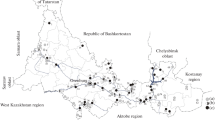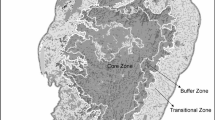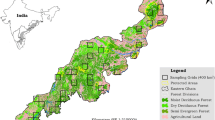Abstract
The bat fauna of the Mora excelsa-dominated rainforest in the Victoria-Mayaro Forest Reserve (VMFR) in south-east Trinidad was assessed over a six-week period. Trapping effort totaled 271 mist net hours and caught 143 bats of 22 species at a rate of one bat every two net-hours. Simpsons diversity index (1/D) was 1.28 for primary Mora forest and extrapolation using Chaos' estimator, a non-parametric method, estimated the total number of species as 39. Phyllostomid bats of the subfamilies Phyllostominae and Stenodermatinae were well represented, and frugivores predominated in number, accounting for 77% of all captures in primary forest. The most abundant bat, the ground-storey frugivore, Carollia perspicillata, accounted for 43% of all captures in primary forest and, in contrast to most bats, was also abundant on man-made paths through the forest. Four species not previously recorded from the reserve, Tonatia bidens, Trachops cirrhosus, a Myotis sp., and the rare Phylloderma stenops, were captured, bringing the total number of bats species known from the reserve to 35. Thus, over half (52%) of Trinidad's 67 bat species occur in this one forest reserve, making it a high priority area for effective protection and management.
Similar content being viewed by others
References
Beard JS (1946a) The Natural Vegetation of Trinidad. Oxford Forest Memorandum, Vol 20. Clarendon Press, Oxford
Beard JS (1946b) The Mora forests of Trinidad, British West Indies. Journal of Ecology 33: 173-192
Bonaccorso FJ (1979) Foraging and reproductive ecology in a Panamanian bat community. Bulletin of the Florida State Museum, Biological Science 24: 359-408
Bradbury JW andEmmons L (1974) Social organization of some Trinidad bats. I. Emballonuridae. Zeitschrift für Tierpsychologie 36: 137-183
Bradbury JW andVehrencamp SL (1976a) Social organization and foraging behaviour in Emballonurid bats. I. Field studies. Behaviour Ecology and Sociobiology 1: 337-381
Bradbury JW andVehrencamp SL (1976b) Social organisation and foraging in Emballonurid bats 2. A model for the determination of group size. Behaviour Ecology and Sociobiology 1: 383-404
Brosset A andCharles-Dominique P (1990) The bats of French Guiana-a taxonomic, faunistic and ecological approach. Mammalia 54: 509-560
Carter CH,Genoways HH,Loregnard RS andBaker RJ (1981) Observations on bats from Trinidad, with a checklist of species occuring on the island. Occasional Papers of the Museum of Texas Technical University No. 72
Chaos A (1984) Nonparametric estimation of the number of classes in a population. Scandinavian Journal of Statistics 11: 265-270
Clubbe CP andJhilmit S (1992) A case study of natural forest management in Trinidad. In: Millar FR andAdaam KA (eds) The Wise Management of Tropical Forests, pp 201-209. Oxford Forestry Institute. Oxford University Press, Oxford
Colwell RK andCoddington JA (1994) Estimating terrestrial biodiversity through extrapolation. Philosophical Transactions of the Royal Society of London B 345: 101-118
Connell JH andLowman MD (1989) Low-diversity tropical rain forests: some possible mechanisms for their existence. American Naturalist 134: 88-119
Davies WB (1980) New Sturnira from Central America and South America, with key to currently recognising species. Occasional Papers of the Museum of Texas Technical University 70: 1-5
Eisenberg JF (1989) Mammals of the Neotropics: the Northern Neotropics, Vol 1. The University of Chicago Press, Chicago
Emmons LH andFeer F (1990) Neotropical Rainforest Mammals: a Field Guide. The University of Chicago Press, Chicago
Fleming TH (1988) The Short-Tailed Fruit Bat: A Study in Plant-Animal Interactions. The University of Chicago Press, Chicago, 365 pp
Goodwin GG andGreenhall AM (1961) A review of the bats of Trinidad and Tobago. Bulletin of the American Museum of Natural History 122: 187-301
Goodwin GG andGreenhall AM (1962) Two new bats from Trinidad with comment on the status of the genus Mesophylla. American Museum Novitates 2080
Goodwin GG andGreenhall AM (1964) New records of bats from Trinidad and comments on the status of Molossus trinitatus. American Museum Novitates 2195
Handley CO Jr. (1987) New species of mammals from northen South America: fruit eating bats, genus Artibeus. Fieldiana Zoology 39: 163-172
Kalko EKV,Handley CO Jr. andHandley D (1996) Organisation, diversity, and long-term dynamics of the Neotropical bat community. In: Cody ML andSmallwood JA (eds) Long-term Studies of Vertebrate Communities, pp 503-533. Academic Press, San Diego
Kerry SM andSmith PG (1992) Bats (Chiroptera) of the Northern Range of Trinidad, West Indies. Open University Research Initiative Report, Open University, Milton Keynes
Koopman KF (1993) Order Chiroptera. In: Wilson DE andReeder DM (eds) Mammal Species of the World, a Taxonomic and Geographic Reference. 2nd edn, pp 137-241. Smithsonian Institution Press, Washington, DC
Kunz TH (1988) Ecological and Behavioural Methods for the Study of Bats. Smithsonian Institution Press, Washington, DC
Kunz TH andKurta A (1988) Capture methods and holding devices. In: Kunz TH (ed) Ecological and Behavioural Methods for the Study of Bats, pp 1-30. Smithsonian Institution Press, Washington, DC
LaVal RK (1973) A revision of the Neotropical bats of the genus Myotis. Los Angeles County Natural History Science Bulletin Vol 15
McCracken GF andBradbury JW (1981) Social organisation and kinship in the polygynous bat, Phyllostomus hastatus. Behavioral Ecology and Sociobiology 8: 11-34
Palmeirim J andEtheridge K (1985) The influence of man-made trails on foraging by tropical frugivorous bats. Biotropica 17: 82-83
Simmons NB andVoss RS (1998) The Mammals of Paracou, French Guiana: A Neotropical Lowland Rainforest Fauna. Part 1. Bats. Bulletin of the American Museum of Natural History, Vol 237, 219 pp
Smith PG andKerry SM (1993) A bat (Chiroptera) survey of the Kurupukari sand plateau. Open University Research Initiative Report, Open University, Milton Keynes
Smith PG andKerry SM (1996) The Iwokrama Rain Forest Programme for sustainable development: how much of Guyana' bat (Chiroptera) diversity does it encompass? Biodiversity and Conservation 5: 921-942
Southwood TRE (1978) Ecological Methods. Chapman & Hall, London
Wood B andGillman MP (1998) The effects of disturbance on forest butterflies using two methods of sampling in Trinidad. Biodiversity and Conservation 7: 597-616
Wood BC,Clubbe C,Gillman MP,Hosie L,Kauffmann JLD andOatham M (1999) A sustainable tropical forest management system in Trinidad. Proceedings of the International Sustainable Development Conference, Leeds, UK, pp 428-434
Author information
Authors and Affiliations
Rights and permissions
About this article
Cite this article
Clarke, F., Downie, J. A bat (Chiroptera) survey of Mora rainforest in Trinidad's Victoria-Mayaro Forest Reserve. Biodiversity and Conservation 10, 725–736 (2001). https://doi.org/10.1023/A:1016617127925
Issue Date:
DOI: https://doi.org/10.1023/A:1016617127925




